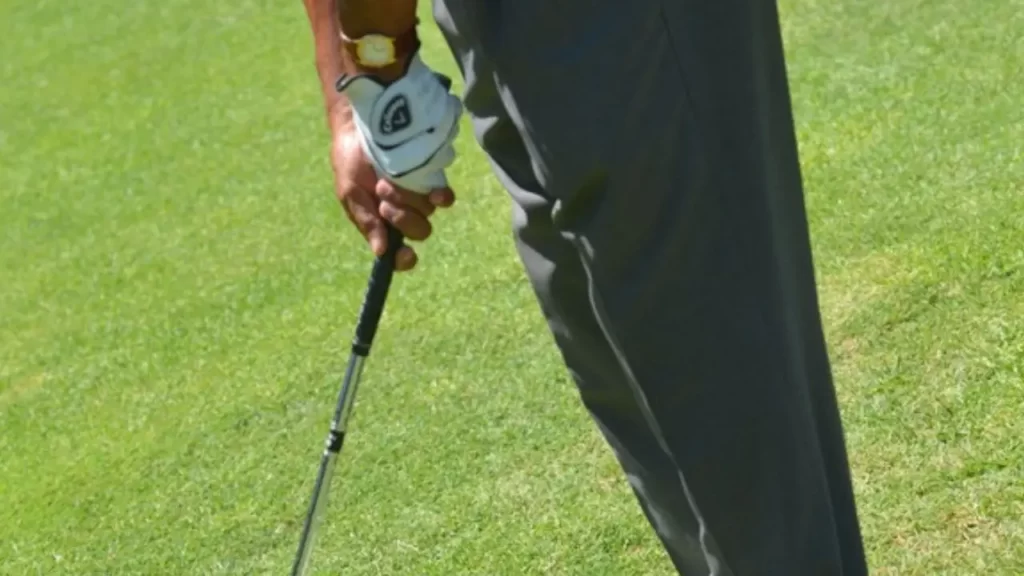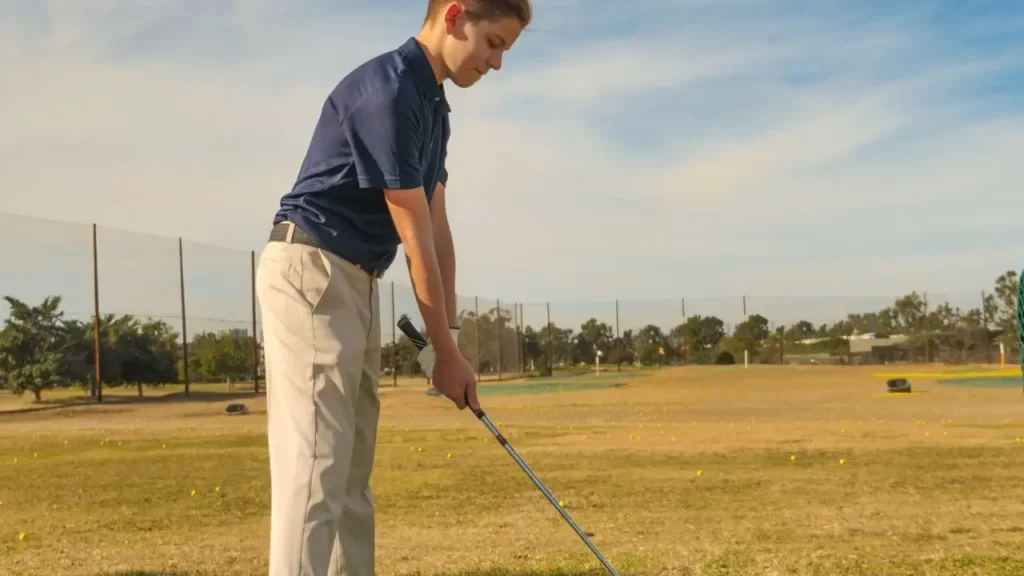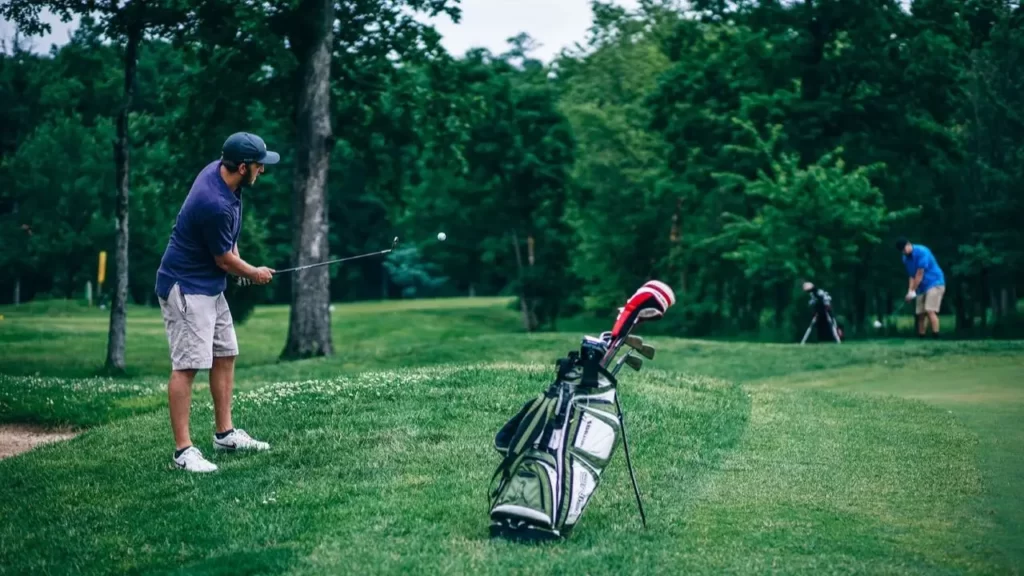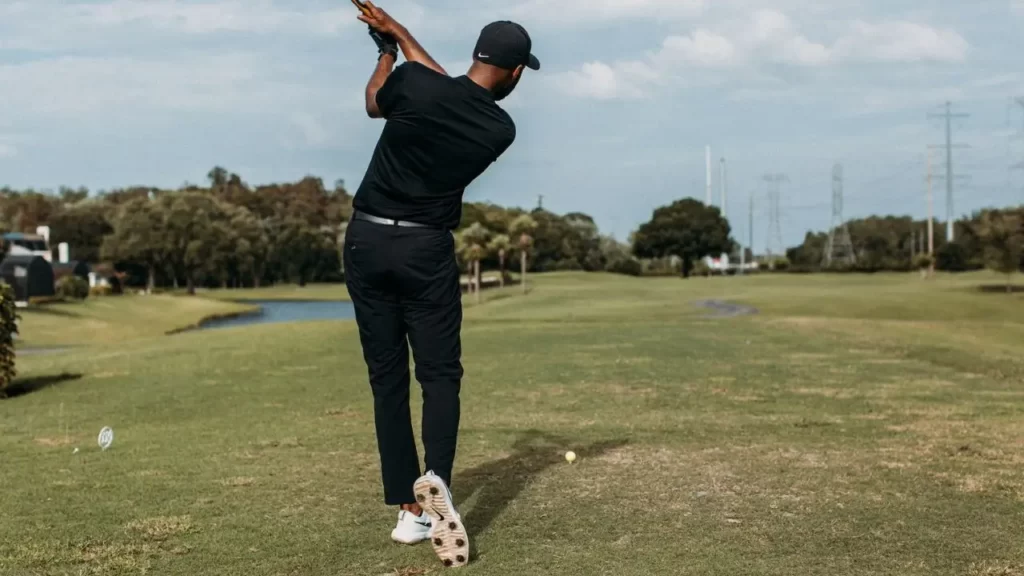Golf Club 101: How to Hold Your Club Right and Left-Handed
- Last updated on November 28, 2023
- Toni Benedito
- Golf Equipment & Gear, Blog
Mastering the art of holding a golf club is the key to unlocking precision in your swing. Whether you’re right or left-handed, the grip sets the foundation for accuracy and ball control. In this guide, we’ll explore the essentials of holding a golf club, from neutral hand positions to common mistakes, providing actionable tips for both right and left-handed golfers. Let’s elevate your game!

Key Takeaways
- Mastering a neutral hand position is crucial for both left and right-handed golfers to enhance control over the clubface and ball trajectory, laying the groundwork for a precise swing.
- Avoiding grip errors, such as holding too tightly or loosely, ensures optimal swing mechanics, improving accuracy and consistency in every shot.
- A proper golf grip directly influences shot accuracy, ball control, and overall performance. Understanding the nuances between left and right-handed grips is essential for maximizing potential on the course.
- Adjusting your grip based on the club and shot type is vital. Whether using a stronger grip for drives or a weaker one for wedges, versatility in grip techniques enhances ball control and accuracy.
- Regularly practicing your golf club grip reinforces muscle memory, leading to a natural and effective hold. Experimenting with different grips for various shots contributes to improved clubface accuracy and overall game success.
Introduction
One of the most important aspects of golf is the grip, which is the foundation of your swing mechanics.
Whether you are a right-handed or left-handed golfer, holding the golf club correctly is essential for achieving target accuracy and controlling ball trajectory. For those who are new to golf, getting the proper golf grip can be overwhelming.
There are many different techniques and hand positions that can be used, making it difficult to know where to start. The good news is that with a little bit of guidance and practice, anyone can learn how to hold a golf club like a pro.
The first lesson when it comes to understanding the basics of a golf grip is learning about neutral hand position. This means positioning your hands so that they feel comfortable on the club while also ensuring your wrists are not locked into any unnatural angles.
A neutral grip helps you maintain control over both the clubface and ball position during your swing. When holding a golf club right-handed, there are several steps you should follow for the best results.
Enjoying this article? Read more:
Check out this video below from Rick Shiels Golf‘s YouTube channel explaining how to hold a golf club correctly:
First, place your left hand at the top of the club with your thumb pointing down towards the ground. Then wrap your fingers around the handle while keeping them relaxed with moderate pressure.
Next, place your right hand just below your left hand and wrap it around in an overlapping grip style with fingers relaxed in slight pressure on fingers and knuckles against each other. Make sure both hands work together in harmony with one another by checking that all ten fingers have contact on one side or another of the overlapping hands.
If you’re a left-handed golfer, then things will be opposite as compared to a right-handed golfer, but still, following the same technique would do wonders, as it is the most effective way amongst all the other ways out there. Mastering this proper golf grip technique as a beginner-friendly club user or otherwise known ones too and practicing regularly from time to time will help you improve your swing mechanics and ball control, ultimately leading to better shots on the course.

Understanding the Basics of a Golf Grip
When it comes to golf, having the right grip on your club is crucial. A proper golf grip can make all the difference in terms of accuracy and swing.
As a beginner golfer or even a seasoned pro, it’s important to understand the basics of a golf grip. Grip pressure is one of the most important things to consider when holding a golf club.
Too tight of a grip can lead to tension in your arms and shoulders, which can negatively impact your swing accuracy. On the other hand, too loose of a grip can result in an unstable club during ball striking.
Another aspect to consider is the neutral hand position. Essentially, this means that your hands should be positioned on the club in a way that feels natural and comfortable.
In addition, maintaining a consistent grip technique will help you improve target accuracy over time. For left-handed golfers, understanding how to properly hold a left-handed golf grip is important.
It may seem like holding the club opposite to right-handed players would be more difficult, but with practice, it becomes natural for lefties too. During your first lesson or when learning how to hold a golf club for the first time, don’t be afraid to ask questions and seek out tips from professionals or experienced players around you.
They may have valuable insights into proper grip technique or ball striking that could help you improve swing accuracy. Overall, mastering the proper golf grip takes practice and patience, but it’s worth investing time into getting it right early on in order to improve your performance on the course in terms of both distance and accuracy!
Enjoying this article? Read more:

How to Hold a Golf Club Right-Handed
When it comes to holding a golf club, there are many different techniques to choose from. If you’re a right-handed golfer, there are a few key things you need to keep in mind in order to hold the club correctly and improve your swing accuracy.
Firstly, it’s important to understand the basics of the golf grip. Your grip is one of the most important aspects of your swing, as it directly affects how you hold a golf club and ultimately how you hit the ball.
There are three main types of grips: the overlap grip, the interlock grip, and the ten-finger or baseball grip. For beginners, I would recommend starting with either an overlap or interlock grip.
To hold a golf club right-handed with an overlapping grip, start by placing your left hand on the club with your thumb pointing down toward the ground. Wrap your fingers around the club and place your right hand over your left hand so that your pinky finger rests between your left index and middle fingers.
Once both hands are on the club, make sure they’re snug but not too tight – you don’t want to strangle the club! If you prefer an interlocking grip instead of an overlapping grip when holding a golf club right-handed, place both hands on the club as if you were using an overlapping grip – but then interlace your pinky finger on your right hand with your index finger on your left hand.
This will give you extra stability when swinging. It’s also important to pay attention to where you place the ball in relation to where you’re standing when holding a golf club right-handed.
Typically, for righties, the ball position should be just forward or center for short irons and wedges while progressively moving further back until reaching just inside the front heel for driver shots. Keep these tips in mind, as they will help improve ball control while also enabling beginners to develop their swing technique when holding golf clubs!

How to Hold a Golf Club Left-Handed
As a lefty, you might feel like golf can be a bit unfair since most instructional materials cater to right-handed players. But don’t worry; we’ve got you covered. Here are some grip tips on how to hold a golf club left-handed.
First off, it’s essential to understand the basics of a golf grip to ensure that you’re doing it right. A proper grip should allow for neutral grip pressure, clubface accuracy, and target accuracy. The simplest way to achieve this is by placing your left hand at the top of the club grip and then interlocking your right-hand fingers over your left index finger.
The aim here is not merely to have a comfortable hold on the club but also to maximize swing power and shot accuracy. Once you’ve locked both hands together, make sure that your palms face each other squarely with no offset angles between them.
Next up is ball position, which is critical in ensuring maximum control over the ball trajectory and shot accuracy. As a lefty, positioning yourself appropriately relative to the ball can be tricky since most courses are designed for right-handed players.
Experts advise that you aim toward hitting the ball straight down from your toes while maintaining an upright spine angle throughout the swing. Swing mechanics play an integral role in holding a golf club left-handed correctly.
You should focus on achieving proper weight distribution between both feet as well as keeping your head still throughout the entire swing sequence. Holding a golf club left-handed requires specific techniques unique to those used by right-handed players.
However, with practice and patience, anyone can develop strong grips that facilitate excellent ball control and target accuracy. Whether it’s your first lesson or you’re looking for more advanced techniques to improve your performance on the course, always remember these tips when trying out new shots!
Enjoying this article? Read more:
Check out this video below from Scratch Golf Academy‘s YouTube channel where they talk about how to grip a golf club:
Common Mistakes in Gripping a Golf Club
When delving into the art of gripping a golf club, navigating the pitfalls of common mistakes becomes paramount. Both novices and seasoned players often find themselves entangled in errors that can significantly impact their swing mechanics, ball control, and overall accuracy on the course.
- Gripping the club too tightly or too loosely is a prevalent mistake, as it introduces tension or compromises control.
- Proper hand alignment is crucial, especially for right-handed players, where the left hand should ideally sit slightly lower on the grip to maintain a square clubface at impact.
- Inconsistent swing paths and improper grip techniques can lead to misaimed shots, emphasizing the need for dedicated practice.
- Neglecting the left-hand grip is a common oversight; both hands must work in harmony to achieve optimal ball control and accuracy.
Avoiding these common pitfalls in your golf club grip is the key to elevating your accuracy and consistency on the golf course. Dedicate time to refining your grip technique, honing your aim, and ensuring your swing mechanics remain steadfast from shot to shot. Whether you’re a beginner navigating the intricacies of a lefty’s perspective or a seasoned right-handed golfer, attention to these grip nuances can significantly enhance your overall performance.
Enjoying this article? Read more:

The Impact of the Grip on the Golf Swing
The way you grip a golf club can have a tremendous impact on the trajectory and accuracy of your shots. A proper golf grip can help you achieve better ball control, improve shot accuracy, and allow you to hit the ball farther.
On the other hand, an incorrect grip technique can lead to hooked or sliced shots that end up far from your intended target. When holding a golf club, your hands are the only physical connection between you and the club.
The grip should be firm yet not too tight, since this can prevent your wrists from moving freely during the swing. With a neutral grip, both hands should be placed on either side of the handle without any excessive twisting or turning.
A good way to check whether you have a proper golf club grip is to take note of where your lead hand’s thumb is positioned. Ideally, it should point straight down toward the ground rather than toward the right or left side of the golf club handle.
Proper hand placement is one of the most important aspects of holding a golf club since it directly impacts how well you can control your shots. For right-handed players, gripping too much with their right hand (the trailing hand) often causes problems like slicing and poor ball trajectory.
"The way you grip a golf club can have a tremendous impact on the trajectory and accuracy of your shots. A proper golf grip can help you achieve better ball control, improve shot accuracy, and allow you to hit the ball farther.
Conversely, gripping too much with their left hand (the leading hand) can cause hooks or pulls on their shots that fly off course in unexpected directions. From a lefty’s perspective, these issues are simply reversed.
However, regardless of whether someone is right-handed or left-handed when playing golf, they must understand how to properly hold their clubs for maximum shot accuracy. Anyone who wants to learn how to play golf should start by mastering the proper golf club grip technique during their first lesson!
Holding a golf club correctly will help beginner golfers develop good muscle memory so they’re able to achieve consistent results from shot to shot. If you’re not sure about how best to grip your clubs for optimal performance after practicing for some time, consider seeking professional help to improve your golfing skills.

Enjoying this article? Read more:
Check out this video below from Meandmygolf‘s YouTube channel where they discuss the perfect golf grip:
How to Adjust Your Grip for Different Shots
As a beginner golfer, it’s important to understand that different shots require different grip techniques. The perfect grip for a driver may not work for a wedge shot, and vice versa.
To achieve better ball control and shot accuracy, you need to adjust your grip based on the club you’re using and the type of shot you want to hit. Let’s start with the driver.
When hitting off the tee, you want to maximize distance while keeping the ball in play. To do that, hold a golf club with a slightly stronger grip than your normal grip.
This means rotating your right hand (or left hand for left-handed golfers) slightly clockwise on the club handle so that more of your knuckles are visible when looking down at the clubface. This will help square up the clubface at impact and promote a high launch angle.
On the other hand, when hitting short approach shots with wedges or irons, you want more accuracy and control over trajectory. For these shots, use a weaker grip by rotating your right hand (or left hand) counterclockwise on the handle so that fewer knuckles are visible on top of your grip.
"For better ball control and accuracy, adapt your grip to the club and shot type. With the driver, a slightly stronger grip promotes distance, rotating your right hand clockwise. Conversely, for approach shots, a weaker grip, rotating counterclockwise, enhances accuracy and reduces spin."
This will help close down the clubface at impact and produce less spin on ball striking. For bunker shots or flop shots around greenside roughs where you need to get under or up onto it quickly but still maintain decent accuracy, aim for an open face to achieve loft easier right before impact by turning both hands toward the target line as much as possible while keeping them in contact with each other.
Remember that as a left-handed golfer, many instructional videos may not cater specifically to the perspective of holding a golf club from this angle, so adjust accordingly or seek out information from different sources where applicable.
Mastering basic golf club grip techniques for different clubs and adapting them based on situational factors like wind direction or slope aiming points can lead to sharper swing mechanics, which ultimately lead to greater accuracy on the golf course.
Enjoying this article? Read more:

Practicing Your Grip
Now that you have a basic understanding of the correct grip technique, it’s essential to practice your grip regularly.
The technique is crucial because it helps you develop muscle memory, allowing you to hold the club properly without thinking about it. One important aspect of practicing your grip is to always check your hand position and grip pressure.
To achieve the perfect grip, make sure that both hands are placed correctly on the club—the left hand on top of the handle for a right-handed golfer and vice versa for a left-handed golfer. Additionally, ensure that there is enough pressure in your hands without squeezing too tightly, which can cause tension in your arms and interfere with your swing.
Another valuable tip when practicing your golf club grip technique is to experiment with different grips when practicing different types of shots. For example, adjusting the position of your left thumb or increasing or decreasing pressure in one hand over another can significantly impact clubface accuracy and improve ball flight.
When working on accuracy in your golf swing, pay attention to where you want the ball to go as well as club selection based on distance from hole to hole. The proper golf grip will vary depending on whether you’re using an iron or a driver.
It’s also essential to consider ball position when holding a golf club; ball placement further back equals a more downward angle versus forward placement, which causes an upward angle. For beginner golfers or those struggling with their current game, consider visiting a local pro for guidance on how best to hold a golf club comfortably while maintaining accuracy.
Remember that, like any skill, perfecting this technique comes with time and practice. By following these tips and remaining consistent in training, holding a proper golf grip will eventually become second nature, regardless of whether you’re a lefty or right-handed golfer!
Check out this video below from Rick Shiels Golf‘s YouTube channel where he shows how to hold a golf club:
Enjoying this article? Read more:

Conclusion
The way you grip the golf club has a significant impact on your golf swing and overall game.
Having a proper grip can lead to better accuracy, ball control, and overall success on the course. Remember to focus on grip pressure, hand position, and neutral grip for both left-handed and right-handed golfers.
It’s important to note that adjusting your grip for different types of shots is also crucial for maximizing your potential on the course. By practicing different grips and techniques, you’ll be able to hit high or low shots with ease while maintaining accuracy and target control.
Improving your putting technique is also an essential part of having good golf basics. Your grip plays a vital role in putting because it affects clubface accuracy and ball trajectory.
Practice holding the putter with a light grip pressure to maintain feel and control over your putts. Don’t forget that there are common mistakes when gripping the club that all golfers make.
By being aware of these errors, you can fix them sooner rather than later, before they become ingrained in your swing. Learning how to hold a golf club properly can be intimidating at first, but with practice, it becomes second nature.
Being aware of proper hand placement and neutral grip, as well as adjusting for different types of shots, will lead to better aim, swing accuracy, target accuracy, ball control, and ultimately lower scores, regardless of whether you are a left- or right-handed golfer. So get out there and work on perfecting that grip!
Share this Post
Toni Benedito
Keep Reading
Follow Us
Recent Posts

How Do Pro Golfers Get Paid? The Business of Golf
Professional golfers get paid both before and after tournaments. Before a tournament, they receive appearance fees, sometimes exceeding $1 million, to attract top players. After the tournament, earnings depend on their placement, with the PGA

How Much Do Golf Players And Pros Make? You Won’t Believe It!
Professional golfers earn substantial incomes through tournament winnings, sponsorship deals, and endorsements. Top players on the PGA Tour can make millions annually, with significant earnings from prize money and lucrative brand partnerships. For example, Rory

The Shocking Cost: How Much Does It Cost to Fly with Golf Clubs?
Flying with golf clubs can be a hassle, but it’s worth it for avid golfers. Costs vary by airline, ranging from $30 to $150 per way. Southwest Airlines offers a generous policy, allowing one set

Why Do Golfers Tape Their Fingers Before Hitting the Course?
Golfers tape their fingers to prevent injuries from repetitive motions, provide support for existing injuries, and improve grip comfort. It’s a popular technique among amateurs and pros alike, offering a lightweight and effective solution compared

How Much Does a Round of Golf Cost? Are You on Par?
The cost of a round of golf varies widely based on factors like course type, location, and time of play. Public courses typically range from $30-$100 per round, while exclusive ones like Augusta National or

Hidden Fees: How Much Does It Cost To Rent a Golf Cart
Wondering how much it costs to rent a golf cart? Explore factors like location, rental duration, and cart type impacting prices. Daily rates range from $50 to $80, while weekly rentals can vary from $200
Table of Contents







